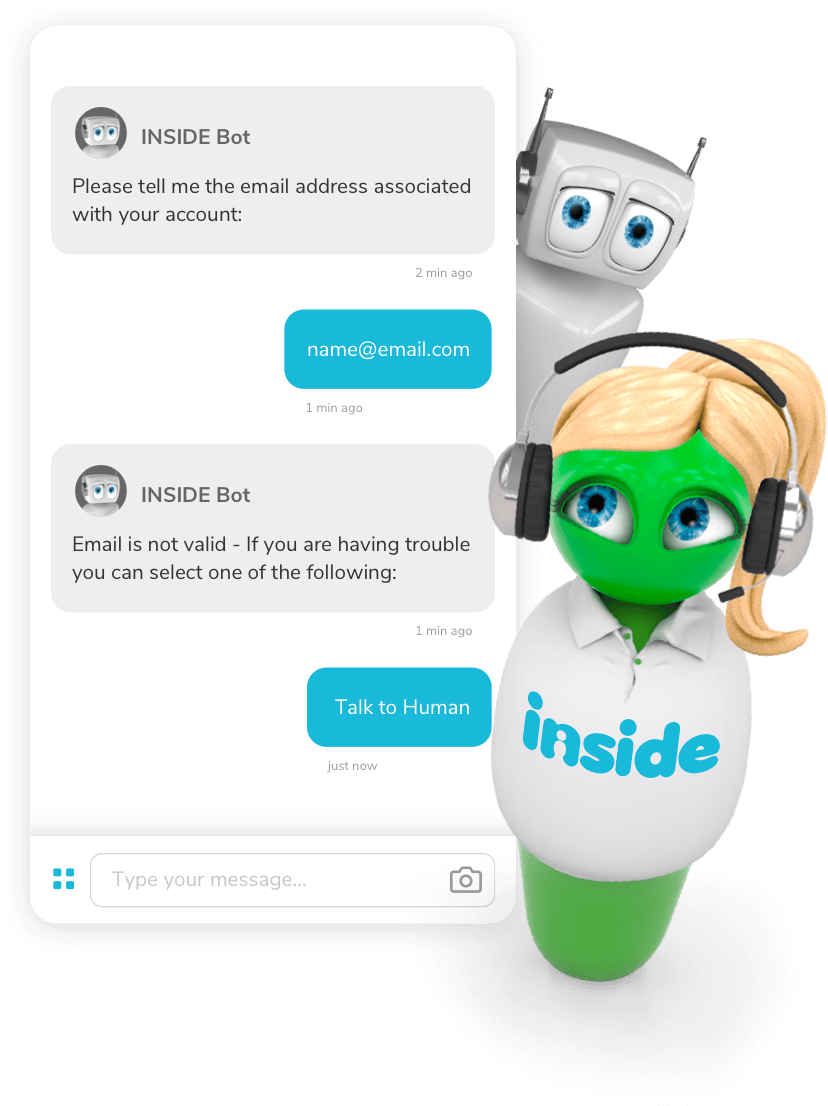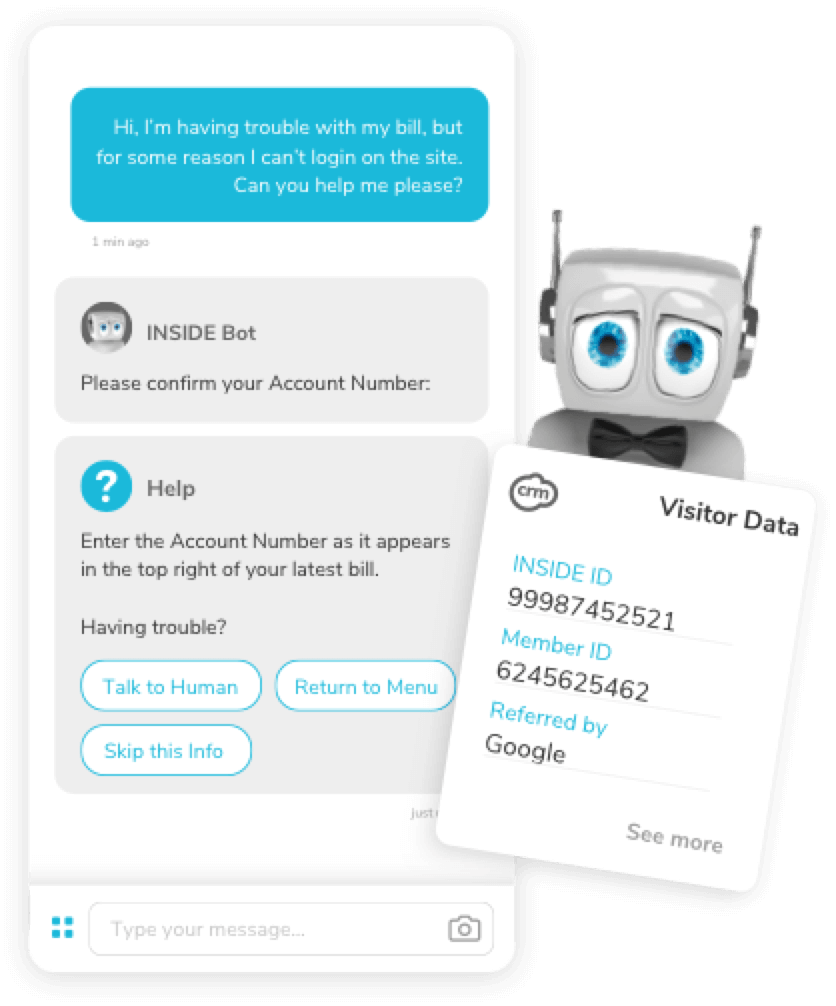A customer walks into your store. Do you send a machine to ask them a list of pre-set questions? Of course not! A customer shops at a luxury retail store to connect with a brand before they buy. That’s why despite attempts from many vendors, AI chatbots in luxury retail have mostly disappointed.
Forrester Research reports that 2 out of 3 consumers are “skeptical of chatbots and their ability to provide just as great an interaction as a live representative.”¹ And they’re right. You want your customers to speak with humans who can understand their nuanced online buying journey. AI bots should offer assistance to operators rather than pretending to be human, therefore minimizing customer friction and ensuring premium customer experience and satisfaction.
The top luxury brands already are offering live service in their online stores. That’s because customers want their shopping experience to mirror that of a physical in-store experience. They want high-touch, hand-held customer service. But how can these brands that rely so much on an intimate customer experience effectively deploy AI technology?
How luxury brands should use AI bots
A luxury purchase is a special occasion. The customer wants the experience to last, they want to feel a sense of belonging, they want to be included in the aspirational lifestyle the brand embodies. If a customer is going to make a high-value purchase, they expect a certain level of service, no matter the purchasing medium.
According to a January 2019 Forrester Report “How To Build A Modern Agent Desktop And Transform Customer Service Experiences” by Kate Leggett, agent-facing chatbots will “clarify intent, surface data, and provide insights to the agent at the right time in an interaction.” Chatbots should prompt customers to engage with support specialists; if the customer responds, the conversation should immediately be transferred to a human agent.
Customers opt for self-service before seeking customer support. When a customer needs to engage, it’s often because there is a problem outside of the typical workflows that a chatbot can support.

AI Bot DON’Ts:
Leveraging chatbots takes careful monitoring and specialization.
1. DON’T pretend to be human
Chatbots should not pretend to be human. Your customers aren’t going to fall for it and won’t appreciate the attempt. Be transparent about who’s handling the customer’s conversation, and how it will be handled from start to finish. Conversations may pass from a chatbot to a human and back again, so ensure the customer knows when a machine has delivered the response so any errors don’t reflect badly on the customer service team.
2. DON’T rely solely on a bot to interact with clients
Don’t always rely on your bot alone to connect with your customers. Some customers will prefer to engage only with a human, and most complex conversations need to be handled by a real person. Your AI chatbots should be used to maximize your agents’ productivity, and provide assistance to ensure efficiency.
3. DON’T lack focus
The diversity of the customer base and the global nature of most deployments mean that quite often language is not correctly processed. Natural Language Processing is getting better, but it’s not perfect by any stretch.. A chatbot should be used to understand the context of the conversation and either direct the visitor into a workflow that can help them solve their problem, or direct them to a human.

AI chatbot DOs:
Put customers at the heart of each interaction.
1. Chat with your customers first.
Your customer chat history will provide a wealth of knowledge about your customers. Agents and management can learn vital data about their customers, their website, and their journey when they engage with and listen to customers in real time. When scoping and building the user questions, intents and workflows for your chatbot, you’ll have all the data right in front of you if you have already been chatting for a few months. This can save you potentially thousands of dollars in scoping and set-up costs.
2. Leverage AI to help your agents.
Many of your customers will choose to engage with a human if they can. That doesn't mean your bot can’t be super useful in helping the agent respond. The best live chat and messaging platforms will have AI built in. The can auto respond to customers mid-conversation with an agent, or automatically pre-populate the right message to respond to a customer based on what the user has asked. This saves valuable minutes off the agent’s handling time and saves the customer’s time as well.
3. Be up front about how the bot can help.
Once the bot has established the context of the inquiry, provide a menu of actions the customer can take. The removes confusion and prevents the endless cycle of customers typing in messages that don’t match an intent. Remember, the bot can't do everything. Clearly point out how it can help, and direct customers onto the right path from the outset.

4. Always give your customers an easy out
...so they can either leave a message if no one is available or they can easily divert to a human. The agent should have access to the conversation history so the transition is seamless and the customer isn’t forced to repeat themselves.
5. Human-guided machine learning
The secret to any good AI-powered chatbot is its ability to learn from the conversations it’s having. Just like in school, your bot needs someone to correct its answers from time to time. The best chat bot solutions provide real-time training of the bot to minimize customer friction and enhance context accuracy. Either way, you should be constantly reviewing the performance and adjusting the intents and user messages as your bot continues to learn.
6. Tight integration
To really add value, the chatbot needs to be tightly integrated with other systems. It needs to be able to authenticate visitors and access CRM, order management systems, commerce platforms and ERP systems in order to resolve the request. The more integrated the bot, the more end-to-end conversations it will be able to handle.
Powerfront are the Luxury AI experts.
Schedule a demonstration to see how you can leverage AI chatbots without creating customer friction.
1 Forrester Infographic: Customer Service Chatbots Fail Consumers Today, January 2019 | By Ian Jacobs, Julie A. Ask, Andrew Hogan
 United States
United States